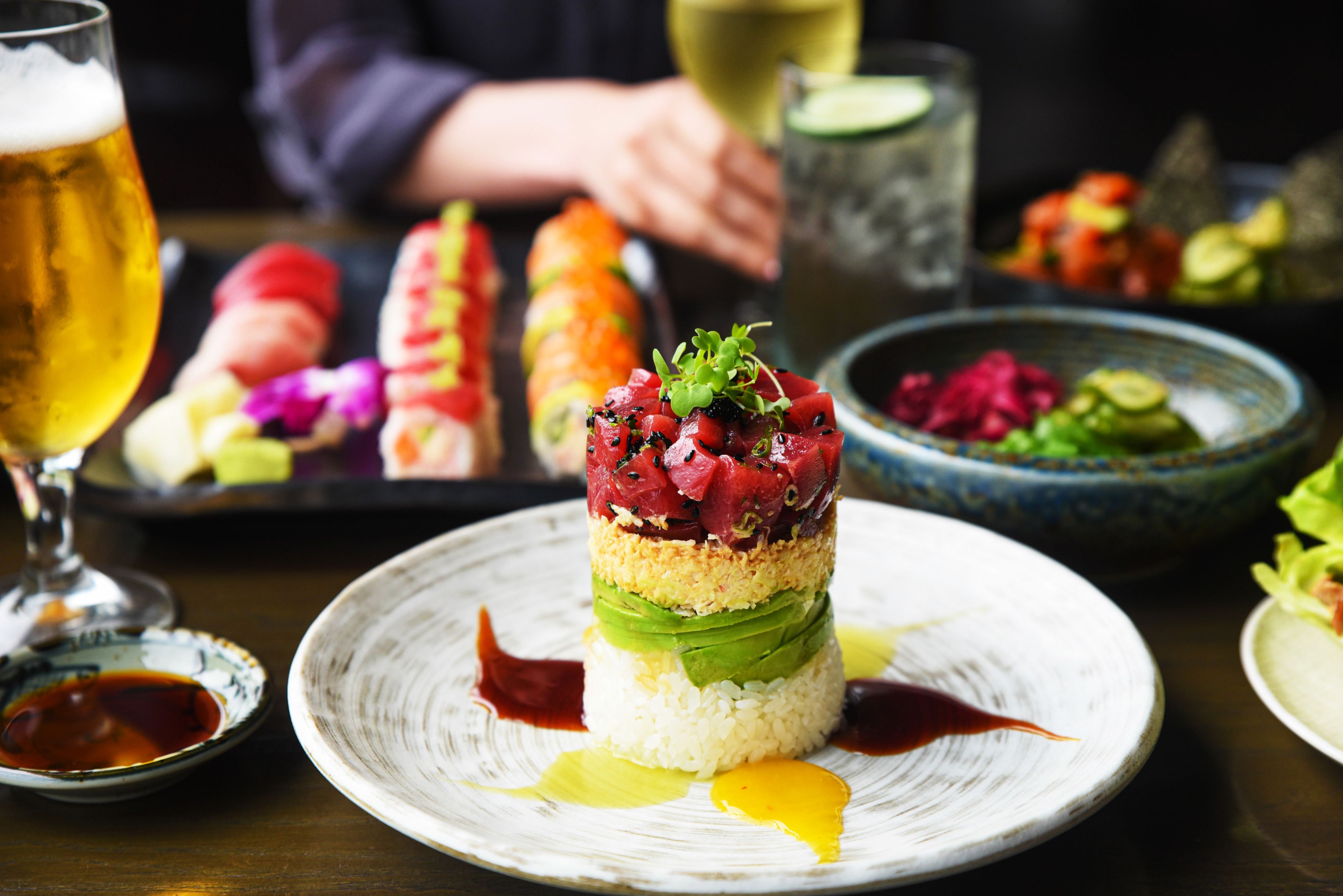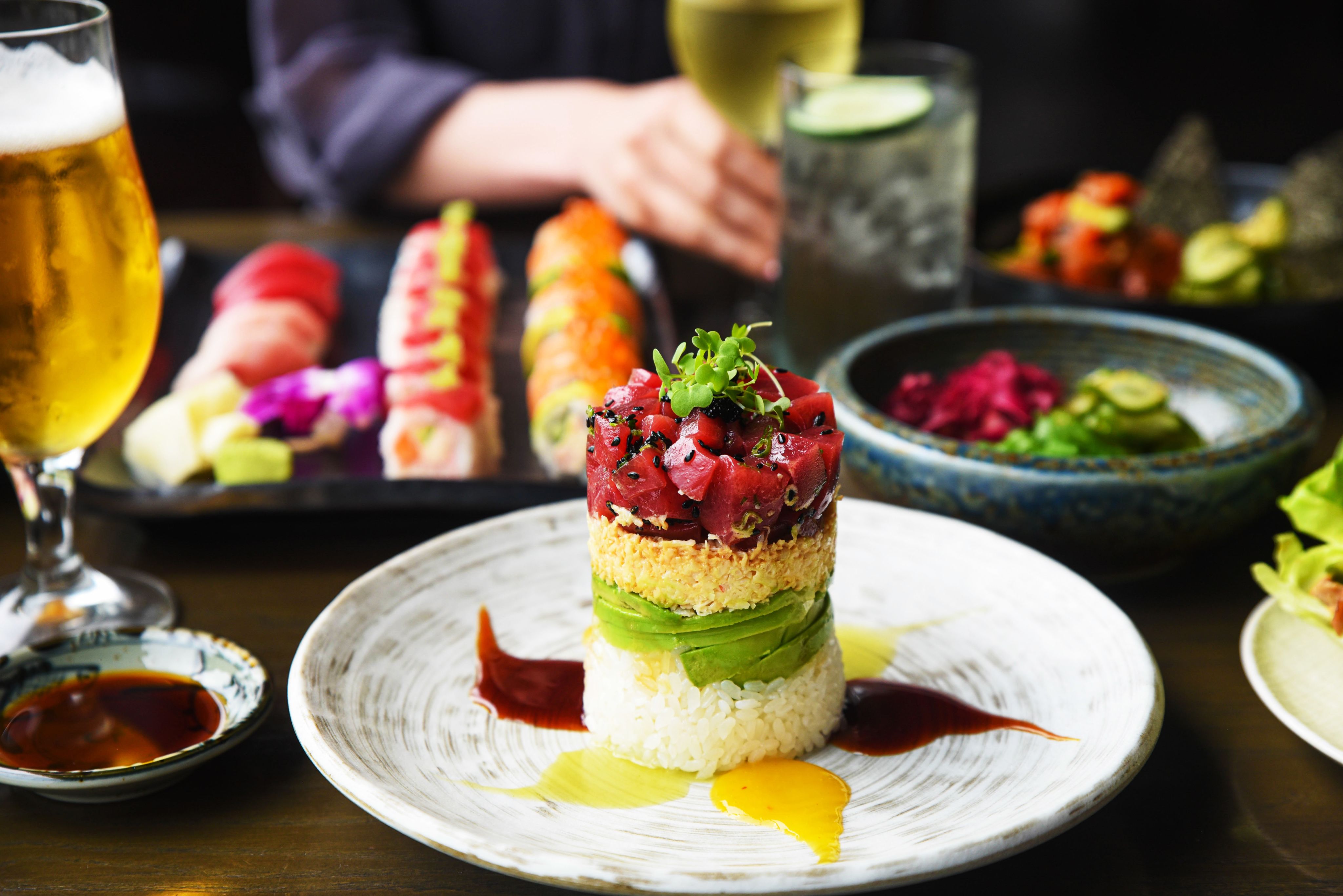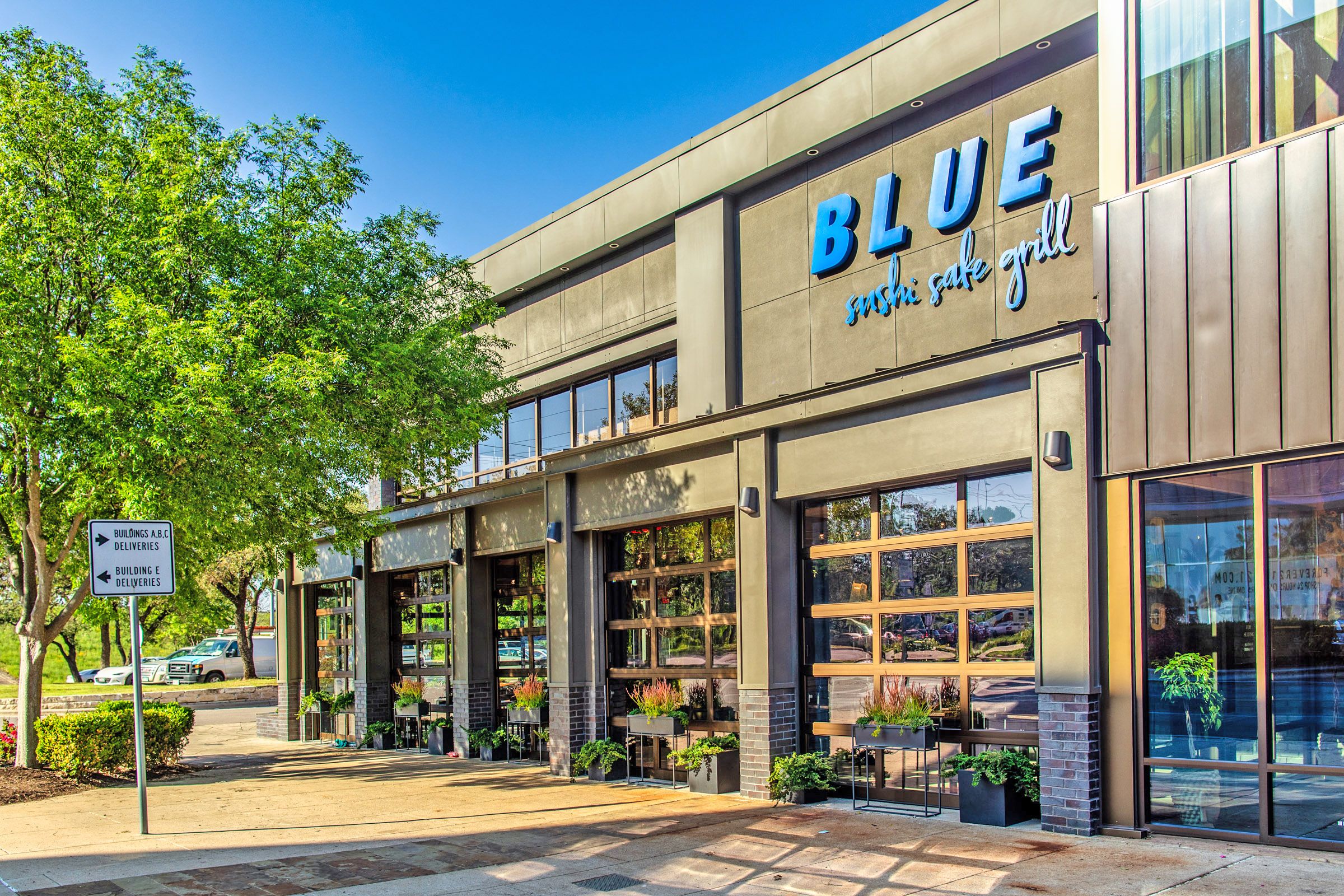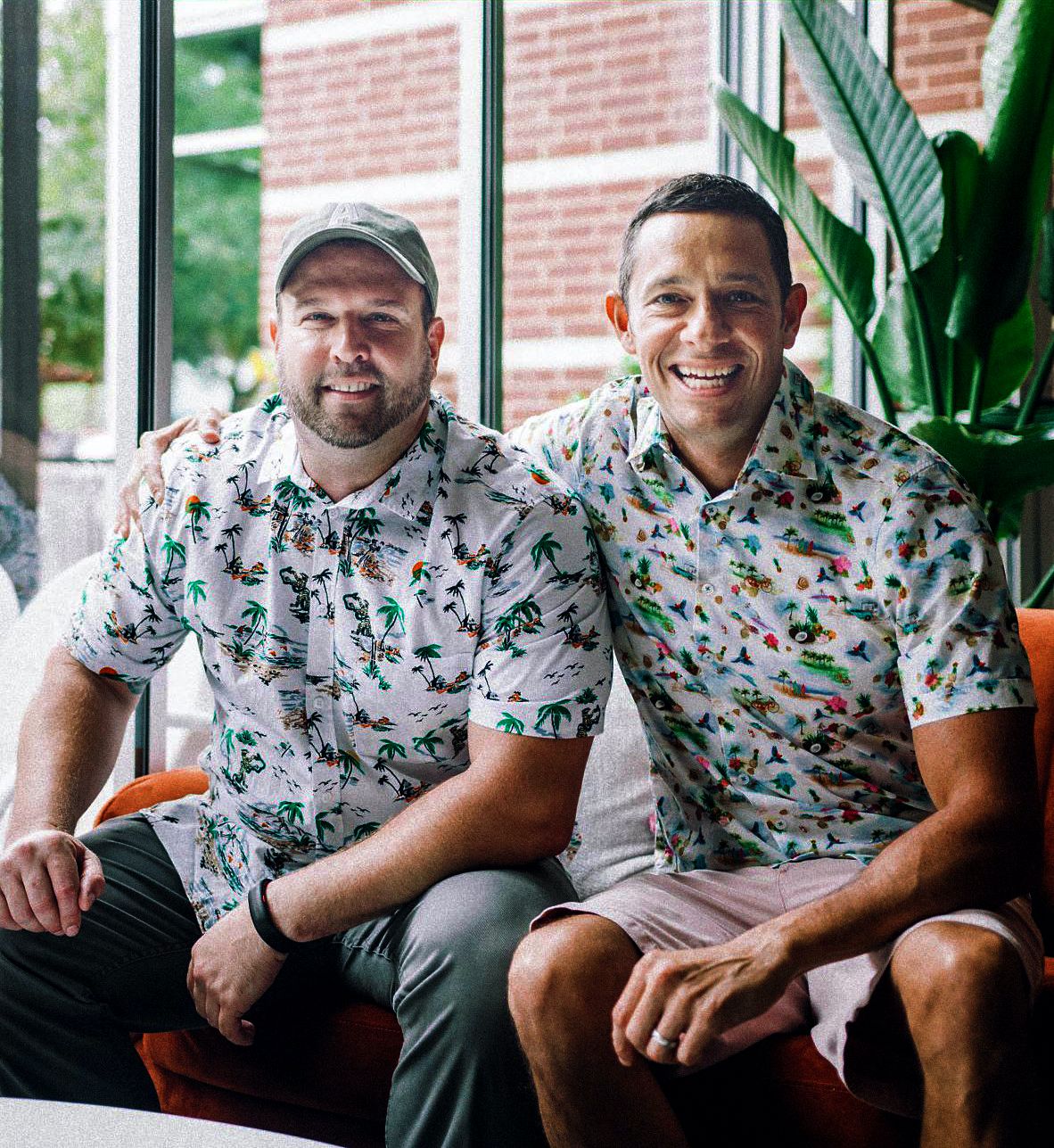Teach a World to Fish (Better)
The brains behind Blue Sushi Sake Grill take sushi to the frontier of sustainability.

Teach a World to Fish (Better)
The brains behind Blue Sushi Sake Grill take sushi to the frontier of sustainability.
By Eve Hill-Agnus

I t wasn’t meant to be a radical empire. It started as a sushi restaurant in Omaha. Tony Gentile and Anthony Hitchcock remember the first menu they put together for their original Blue Sushi Sake Grill, working out ambitious combinations from brown paper sacks of groceries in a small, two-bedroom apartment in the “Gateway to the West.” They couldn’t imagine then that their sea-changing business based on a commitment to sustainability would grow to 18 locations in 10 states over the next two decades.
The duo met in passing as sophomores at the University of Houston, both studying at the Conrad N. Hilton College of Global Hospitality Leadership and working at the then-game-changing Italian deli Eatzi’s. But their friendship sparked when they discovered that their favorite pastime brought them both separately to Galveston’s beckoning bay, fishing from near sunset to near sunrise, gripped by the same passion that implied a reverence for water and the life with which it teemed.
They were out fishing so frequently, “my wife threatened, jokingly,” Hitchcock says, that it might come down to either her or the sea.
They would both work at Houston’s first H-E-B Central Market, Gentile in a lead culinary role and Hitchcock at the seafood counter, knitting ties with fish purveyors. But when a cousin of Hitchcock’s, Nick Hogan, called to see if his former childhood fishing buddy wanted to move to landlocked Omaha to open a sushi restaurant, “I knew it was coming,” Hitchcock says — that trends “work their way toward the center of the country.”
Houston already had scores of sushi restaurants; Omaha had one. The risk was there for the taking but also the reward — especially if they could make a difference. “This was probably 2002, and at that time, sushi was just on fire,” Hitchcock says.
And so, a culinary pro (Gentile), a newly graduated manager (Hitchcock), a lawyer with a knack for finance (Hogan) and an architect (friend Tom Allisma) joined forces in happenstance and serendipity. “Our goal was just to open one restaurant,” Hitchcock says.
Sourcing Sustainably
Sustainable, responsibly sourced seafood was a siren song from the start.
Gentile became the sourcing guy, throwing himself into the tangled net of what is notoriously a labyrinthine and frustratingly opaque subject, fraught with moving targets and moral dilemmas.
Despite the difficulties, “I fell in love with it right away. [I admired] the people who were already ahead of their time. It kept opening these doors,” Gentile says. Organizations helped him feel like he and his partners weren’t “on an island by ourselves, educating ourselves along the way.”
He partnered with the Monterey Bay Aquarium’s Seafood Watch program, whose consultation led to an overarching policy they could adopt across each restaurant in each state as a bulwark against destructive practices, against the specter of endangered species and overfishing.
They found Dutch yellowtail raised in the Netherlands in a recirculating aquaculture system. Or American Unagi, a company in Maine that sustainably breeds eels in indoor recirculating aquaculture systems.
The finds culminate in a menu that lists with utter transparency where and how marine species are caught or farmed. Diners know their ikura (salmon roe pearls) were hoisted by purse seines in Alaska, their bonito pole-caught in Japan.
There were friction points. “I would make an incredible relationship with someone who was longline catching in the Maldives. And he’s doing all the right things. He’s got guys on deck watching the bycatch,” Gentile says. But he’d approach Seafood Watch, and they’d nix the source, “because the fishery as a whole isn’t doing what it’s supposed to.” These, he says, were “Aha! moments.” Ones he came to crave.
And as they grew, so did their ability to effect change. “Initially we weren’t large enough to make an impact that was significant enough to put pressure on these larger companies,” Hitchcock says. But now their restaurant group goes through 4,000 pounds each of tuna and salmon weekly. “So, when you think about the volume, that’s a lot of fish to take out of the ocean. If we’re not doing our part of responsible fishing, then we’re not making an impact down the road.”
 edit copy-1182x1287.jpg)
Tony Gentile (left) and Anthony Hitchcock
Tony Gentile (left) and Anthony Hitchcock


Tony Gentile (left) and Anthony Hitchcock
Tony Gentile (left) and Anthony Hitchcock
The duo met in passing as sophomores at the University of Houston, both studying at the Conrad N. Hilton College of Global Hospitality Leadership and working at the then-game-changing Italian deli Eatzi’s. But their friendship sparked when they discovered that their favorite pastime brought them both separately to Galveston’s beckoning bay, fishing from near sunset to near sunrise, gripped by the same passion that implied a reverence for water and the life with which it teemed.
They were out fishing so frequently, “my wife threatened, jokingly,” Hitchcock says, that it might come down to either her or the sea.
They would both work at Houston’s first H-E-B Central Market, Gentile in a lead culinary role and Hitchcock at the seafood counter, knitting ties with fish purveyors. But when a cousin of Hitchcock’s, Nick Hogan, called to see if his former childhood fishing buddy wanted to move to landlocked Omaha to open a sushi restaurant, “I knew it was coming,” Hitchcock says — that trends “work their way toward the center of the country.”
Houston already had scores of sushi restaurants; Omaha had one. The risk was there for the taking but also the reward — especially if they could make a difference. “This was probably 2002, and at that time, sushi was just on fire,” Hitchcock says.
And so, a culinary pro (Gentile), a newly graduated manager (Hitchcock), a lawyer with a knack for finance (Hogan) and an architect (friend Tom Allisma) joined forces in happenstance and serendipity. “Our goal was just to open one restaurant,” Hitchcock says.
Sourcing Sustainably
Sustainable, responsibly sourced seafood was a siren song from the start.
Gentile became the sourcing guy, throwing himself into the tangled net of what is notoriously a labyrinthine and frustratingly opaque subject, fraught with moving targets and moral dilemmas.
Despite the difficulties, “I fell in love with it right away. [I admired] the people who were already ahead of their time. It kept opening these doors,” Gentile says. Organizations helped him feel like he and his partners weren’t “on an island by ourselves, educating ourselves along the way.”

He partnered with the Monterey Bay Aquarium’s Seafood Watch program, whose consultation led to an overarching policy they could adopt across each restaurant in each state as a bulwark against destructive practices, against the specter of endangered species and overfishing.
They found Dutch yellowtail raised in the Netherlands in a recirculating aquaculture system. Or American Unagi, a company in Maine that sustainably breeds eels in indoor recirculating aquaculture systems.
The finds culminate in a menu that lists with utter transparency where and how marine species are caught or farmed. Diners know their ikura (salmon roe pearls) were hoisted by purse seines in Alaska, their bonito pole-caught in Japan.
There were friction points. “I would make an incredible relationship with someone who was longline catching in the Maldives. And he’s doing all the right things. He’s got guys on deck watching the bycatch,” Gentile says. But he’d approach Seafood Watch, and they’d nix the source, “because the fishery as a whole isn’t doing what it’s supposed to.” These, he says, were “Aha! moments.” Ones he came to crave.
And as they grew, so did their ability to effect change. “Initially we weren’t large enough to make an impact that was significant enough to put pressure on these larger companies,” Hitchcock says. But now their restaurant group goes through 4,000 pounds each of tuna and salmon weekly. “So, when you think about the volume, that’s a lot of fish to take out of the ocean. If we’re not doing our part of responsible fishing, then we’re not making an impact down the road.”
Forcing Change
Gentile is not shy about touting the thrill of a snowball effect. “At the end of the day, the ultimate goal is to force change. And to force change is to leverage your purchasing power to get the companies [in this case, purveyors and the fisheries they source from] to see you’re serious. And either you’re on board or you’re not. And at first, they didn’t take us seriously. And then, it just started to flow. Because they saw it was serious.”
The company is on pace to open six to eight Blue Sushi Sake Grills a year, each location sourcing 800 pounds of fish weekly. “So, if good fortune continues and we’re able to open those across the country, that’s a big shift,” says Hitchcock.
“I think it’s slow and steady wins the race,” Gentile says. “Some people want to hear it; some don’t. But I do think we’re starting to see a shift. [The younger demographic] are growing up in a world where there may not be a world.” The urgency feels palpable.
The vegan sushi they rolled out nine years ago, whose 18 rolls and seven nigiri offer staggeringly diverse options, is the place on the menu where they arguably make the most environmental impact. And it’s one of the areas that’s most intriguing to discover: brands like Caviart, whose plant-based caviar might mimic the jewel-dots of tobiko (flying fish roe), or Kuleana, the plant-based seafood startup whose plush, ruby-colored vegan tuna Time magazine named one of the top inventions of 2021. Currently, the vegan menu shifts the most, as new products enter the market — such as the faux smoked salmon that was, as I spoke with Gentile and Hitchcock, poised to give one of their best-selling rolls a plant-based sister. Their two missions dovetail.
They’re always looking toward the next frontier of sustainability. “Because of our love of the sea,” Gentile says. And because the need is primordial.
Forcing Change
Gentile is not shy about touting the thrill of a snowball effect. “At the end of the day, the ultimate goal is to force change. And to force change is to leverage your purchasing power to get the companies [in this case, purveyors and the fisheries they source from] to see you’re serious. And either you’re on board or you’re not. And at first, they didn’t take us seriously. And then, it just started to flow. Because they saw it was serious.”
The company is on pace to open six to eight Blue Sushi Sake Grills a year, each location sourcing 800 pounds of fish weekly. “So, if good fortune continues and we’re able to open those across the country, that’s a big shift,” says Hitchcock.
“I think it’s slow and steady wins the race,” Gentile says. “Some people want to hear it; some don’t. But I do think we’re starting to see a shift. [The younger demographic] are growing up in a world where there may not be a world.” The urgency feels palpable.
The vegan sushi they rolled out nine years ago, whose 18 rolls and seven nigiri offer staggeringly diverse options, is the place on the menu where they arguably make the most environmental impact. And it’s one of the areas that’s most intriguing to discover: brands like Caviart, whose plant-based caviar might mimic the jewel-dots of tobiko (flying fish roe), or Kuleana, the plant-based seafood startup whose plush, ruby-colored vegan tuna Time magazine named one of the top inventions of 2021. Currently, the vegan menu shifts the most, as new products enter the market — such as the faux smoked salmon that was, as I spoke with Gentile and Hitchcock, poised to give one of their best-selling rolls a plant-based sister. Their two missions dovetail.
They’re always looking toward the next frontier of sustainability. “Because of our love of the sea,” Gentile says. And because the need is primordial.

